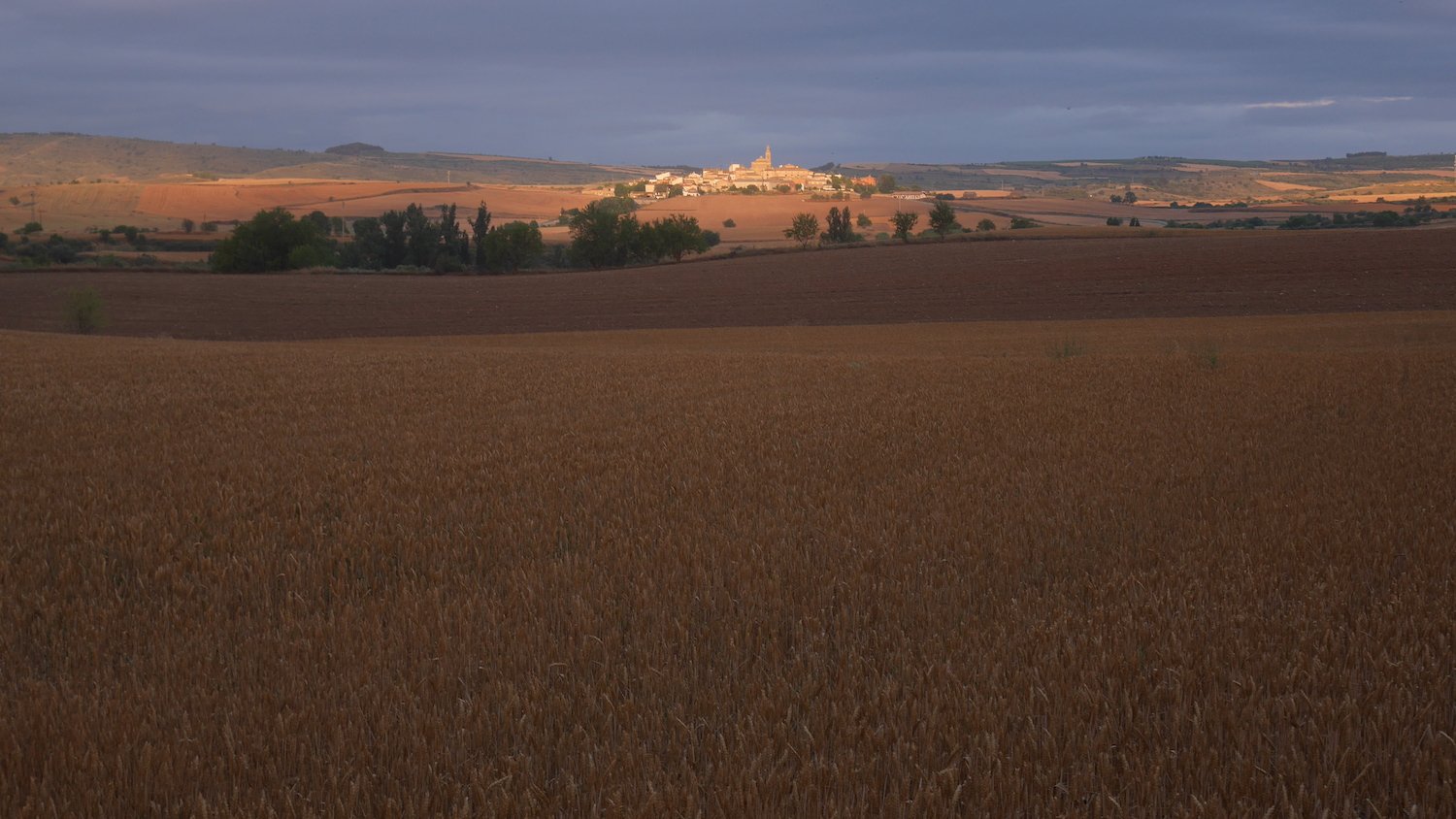We passed a significant mark. There was no signage that I recall, and, if not for Brierley’s guidebook (which I was discarding page by page in order to “save weight”), I’m not sure that we would have even known it.
Since stepping off the bus in St-Jean-Pied-de-Port, Bob and I had walked 100 miles of the Camino Francés. No doubt, the first twenty-five were the toughest so far (crossing the Pyrénées). Beyond that, the terrain rolled out like an old burlap bag. The hills were soft and fraying, the watersheds were wide. When we did meet a stream, it was feeble. The Spanish sky, on the other hand, was sapphire and ponderous. It pressed hard against the land.
Clouds on La Sierra de Codés.
Only 400 miles separated us from this spot in Navarre and the Cathedral of Santiago de Compostela. My mind tried to hide that number from my feet. It was too much.
One day at a time, sweet Jesus That's all I'm asking of You Just give me the strength to do everyday What I have to do.
Perhaps it was the rhythm of walking, the inner energy devoted to growing new brain cells,* or simply the choice to seize the moment more with the eye than with the lens—whatever—the number of photographs in my camera began to decrease after the first week. My notetaking took a downturn as well.
Our path cut through the Pyrenees and ran south of the Basque and Cantabrian Mountains. Image courtesy of the site here.
La Sierra de Codés dominated the northern horizon. This feature belonged to a larger range sometimes called the “Basque Mountains.” The scarps of this 4,000-5,000-foot barrier stood between us and the Bay of Biscay (Atlantic Ocean). Experts wrangle over the relationship between the Basque Mountains and the Pyrenees and the Cantabrians. These three chains are linked across the top of the peninsula. One might be tempted to demean the Basque Mountains as “transitional” if not for the eloquence of Aubrey Bell. Her “Basque Threshold” gives the center a reason to be considered on its own merit.**
We hiked from Los Arcos to Longrono. It was an 18-mile day, largely rural in character. This was a good thing. Natural surfaces were kinder to the knees than blacktop.
The sun played through the clouds on our approach to Sansol. It was a tiny place, like many Spanish hamlets, dominated by a single church house. The 18th-century structure topping the knob, however, was not the 12th-century hospitum mentioned in several sources.*** This pilgrim shelter, now completely erased, belonged to the Hospitallers of Saint John of Jerusalem (or simply Knights Hospitallers), a formidable military order of Crusader period. In Spain, as in Israel-Palestine, they tended sick, poor, or injured peregrinos (among other things).*** I wondered what this hamlet would have looked like in the 12th-century. The surrounding fields seemed eternal.
Cereal fields surrounded the village of Sansol.
With the crunch of gravel we were overtaken by a strider. To our surprise, it was Greg! We hadn’t seen him since Pamplona. He had given us lessons in checking a bunk for chinches (bedbugs) in Zubiri (see post here). Greg was working on his second Camino and was insistent on traveling alone. We agreed to look for each other down the trail. We walked together for a time and then parted. Greg shot ahead, grinning silly. We each offered the customary exchange.
¡Buen Camino!
Greg was long and skinny and on the way.
*They say (they being psychology-types) that walking is crucial for helping memory and mood. Part of this may be linked to the connection between exercise and the act of pumping out new brain cells. Check out the article here in Psychology Today or here in The New York Times.
**See Aubrey F. G. Bell, “The Basque Threshold” in Bulletin of Hispanic Studies 24/93 (Jan 1, 1947): 5-10.
***See T. López Selles, Contribución a un catálogo de ermitas de Navarra (1973). A pdf of this work is posted here. Find the entry for Sansol on page 195.
****For an introduction to the Knights Hospitallers, see the work by Ernle Bradford, The Shield and the Sword: The Knights of Malta. Open Road, 1972. Further afield, I cannot say enough good things about the experience of reading Roger Crowley, Empires of the Sea: The Siege of Malta, the Battle of Lepanto, and the Contest for the Center of the World. Random House, 2009.
With travel restrictions easing, we have a full slate of Bible Land trips ready to launch in 2022. Check out a complete list by clicking here or perusing under the heading “Find your Trip.” For more information on how to join one of these trips or if you are interested in helping to craft a unique trip for your own group, church, or school, contact me at markziese@gmail.com.





